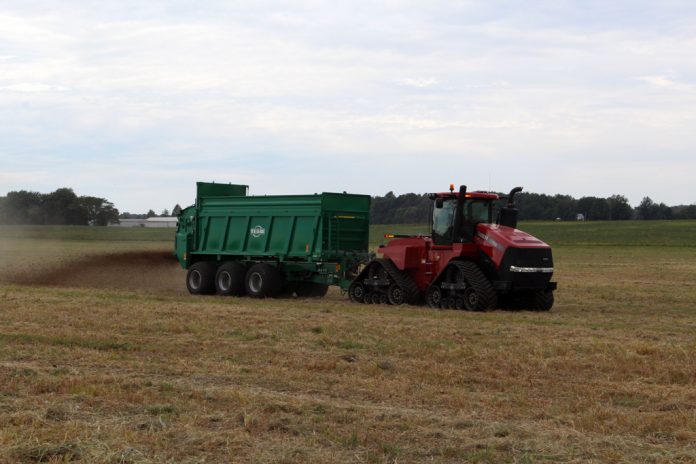As both legislative and public scrutiny of water quality increases within the state, it is clear that dairy producers must manage manure applications to preserve water quality and minimize detrimental environmental impacts.
The driver in these conversations is phosphorus.
Application rate
Good manure management depends upon determining a correct manure application rate, being aware of environmental conditions and observing setbacks.
There are three pieces of information needed to determine a correct manure application rate, a current soil test, a nutrient analysis of the manure, and a realistic crop yield goal.
For many dairy farms, soil test phosphorus levels determine the amount of manure to apply.
From an agronomic perspective, no crop yield increase or economic benefit is expected once soil test phosphorus is at or above 25 ppm (Bray P1) or 40 ppm (Mehlich 3) in a crop rotation that includes wheat and/or alfalfa.
Current Tri-State Fertilizer Recommendations, Extension bulletin E-2567, recommends zero pounds of phosphate fertilizer applied to fields that include wheat and/or alfalfa in the rotation once soil test phosphorus levels reach 50 ppm Bray P1 or 70 ppm Mehlich 3.
In agronomic terms, the 25-ppm level is called the critical level; the range between 25 ppm and 50 ppm is the maintenance range and above 50 ppm is the no apply range.
Manure
The next piece of information needed is the nutrient analysis of your manure. Book values may put you in the ballpark regarding nutrient concentration but may not be accurate for your farm.
Manure nutrient analysis can vary widely depending upon livestock species, class of livestock within a species, the diet or ration consumed, type and amount of bedding material used, and how manure is stored and handled.
In other words, test the manure on your farm. Test the manure coming out of the calf barns, and heifer barns separately from the manure coming out of the lagoon or liquid manure storage structure.
If you are not sure of how to pull a good, representative manure sample, contact your local Extension office, Soil and Water Conservation District office or testing lab to get more information and help.
Yield
The third piece of information needed is a realistic crop yield goal. Crop yield determines nutrient removal. From a water quality perspective, we are concerned with phosphorus.
Each bushel of corn grain removes 0.37 pounds of phosphate (P2O5), each bushel of soybeans removes 0.80 pounds of P2O5, each bushel of wheat grain removes 0.63 pounds of P2O5, each ton of corn silage removes 3.30 pounds of P2O5 and each ton of alfalfa forage removes 13 pounds of P2O5.
For those fields where the soil test phosphorus level is at or above 25 ppm Bray P1 or 40 ppm Mehlich 3, the manure application rate is limited to crop removal rate.
Without a realistic crop yield goal based on history, with some adjustment for trend yield increase due to crop genetics, soil test phosphorus levels can increase rapidly with excessive manure applications.
This is because it requires 20-22 pounds of P2O5 removed to decrease soil test phosphorus by 1 ppm.
A 180 bushel per acre corn crop removes approximately 66 pounds of P2O5, resulting in a soil test decrease of only 3 ppm for phosphorus. A 28-ton corn silage yield will remove enough P2O5 to decrease a soil test phosphorus level by 5 ppm.
The take-home message here is that once soil test phosphorus reaches that no apply or higher level, it takes many years without any manure application to bring soil test phosphorus levels back into the more environmentally sound maintenance range.
Runoff
As those dairy farmers in the Western Lake Erie Basin are well aware, environmental conditions are another part of manure management.
Currently, that area of the state has restrictions on manure application to saturated soils, snow-covered or frozen soils and no application when the local weather forecast calls for greater than a 50 percent chance of precipitation exceeding one-half in within the 24-hour period of intended application.
The objective is to keep manure from moving off the field with a heavy rainfall event. Manure incorporation is encouraged.
Even though dairy farms in other parts of the state are not under this law, the NRCS 590 practices standard that the law is based on, are the manure application guidelines for the rest of the state.
Setbacks
Finally, good manure management observes setbacks. These setbacks are defined in the NRCS 590 practices standard, as well as Ohio Revised Code.
Manure application setbacks have to be observed with regard to residences and private wells, ponds, lakes, streams, ditches, surface inlets, grassed waterways, field surface drains, public wells, developed springs and public surface drinking water intakes.
Setback distances vary depending upon the type of sensitive area and range from a minimum of 35 feet if there is a vegetative barrier to 300 feet regardless of the vegetative cover.
In some cases, incorporating or injecting manure can reduce setbacks. Contact your local NRCS office for more details about specific setback distances.













